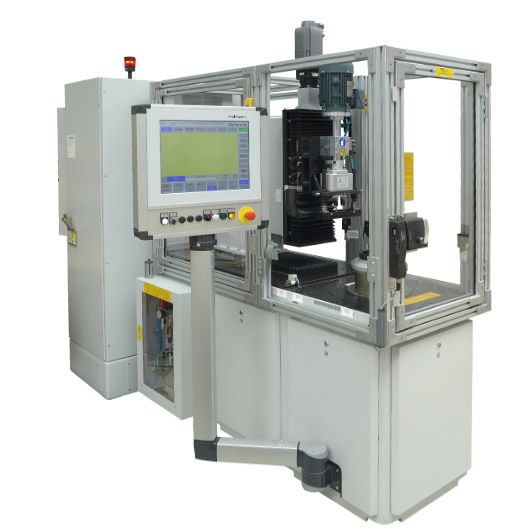Whether synchronous motor (PSM - permanently controlled synchronous machine),
asynchronous motor (squirrel-cage rotor) or hybrid rotor: Hofmann offers tailormade machine concepts to compensate for unbalance for every rotor type
The Hofmann machines for unbalance compensation of electric rotors and hybrid rotors are consistently modular in design. In this way, they can grow at any time with the requirements of the user. You can equip your Hofmann balancing machine with intelligent measuring technology, or expand it with handling systems up to a fully automatic balancing station.
Because Hofmann develops all components and assemblies in-house, all modules such as measurement technology, handling systems, unbalance compensation or full automation are perfectly coordinated. High availability, durability and perfect balancing results are therefore no coincidence. They are the result of many years of experience, extensive expertise in balancing technology and high engineering skills.
Depending on your requirements for precision or cycle times, we build our balancing machines for e-rotors as 1-, 2- or multi-station machines. We always pay attention to the highest precision. Our EHK machines can, for example, be equipped with a ground block including a highly sensitive and vibration-isolated measuring platform, which enables uniquely precise balancing results.
Due to the vibration-isolated structure, these machines can be set up free of any foundation requirements. Our balancing machines are loaded manually, by means of robots or loading gantries, or using a specially developed rotary transfer.
Do you have special tasks, such as spinning rotors?
We have the solution! It is often unavoidable to spin the rotor to its later operating
speed due to a possible displacement of the imbalance within the laminated core of
the e-rotor or due to the subsequent setting of the permanent magnets at a higher
speed. Hofmann has developed tailor-made centrifugal stands for this special task.
We test and document the unbalance behavior of rotors when the speed changes. We are also happy to carry out spin tests using the contract balancing process. Please don’t hesitate to contact us.
Vertical Spin bench for E-rotors type ESV25-AR
The balancing of electric rotors also includes accelerating them to their later operating speed in the vehicle. This run-up to operating speed - also known as spinning - often leads to a shift in the mass of the laminated cores within the rotor, which in turn leads to a changed unbalance.
With regard to the relatively low unbalance tolerances of the E-rotors, a centrifugal process is essential, so that this is part of the balancing of the rotors.
The Hofmann spin benches are available in a horizontal and vertical orientation.
Loading can be done manually or automatically by a robot.
Special Features
Applications

2-plane measuring and balancing machine for high-speed E-Armature type EHK12.1
For the balancing of e-armatures and hybrid rotors in the context of e-mobility, HOFMANN has developed flexible machine concepts according to the tasks. The low unbalance tolerance, due to the high operating speeds in relation to the rotor weight, places high demands on the measuring platform / device.
Different machine concepts are available depending on the requirements. From the manual 1-station machine (measuring and balancing in one station) to the fully automatic 2-station machine (measuring and balancing separately in 2 stations).
The unbalance compensation can be carried out, depending on the rotor type, by means of axial or radial drilling, or e.g. done by riveting weights. The decision about the required number and structure of the stations depends on the cycle time requirement and the selected machine concept.
Loading can be done manually or automatically via a robot or a loading portal.
Special Features
Applications

2-plane measuring and balancing machine for high-speed E-armature type EHK12-BBH2
For the balancing of e-anchors in the context of e-mobility, HOFMANN has developed flexible machine concepts according to the tasks. The low unbalance tolerance, due to the high operating speeds in relation to the rotor weight, places high demands on the measuring platform.
Different machine concepts are available depending on the requirements. From the manual 1-station machine (measuring and balancing in one station) to the fully automatic 2-station machine (measuring and balancing separately in 2 stations). The unbalance compensation can take place via axial or radial drilling, depending on the rotor type. The decision about the required number and structure of the stations depends on the cycle time requirement and the selected machine concept.
Loading can be done manually or automatically via a robot or a loading portal.
Special Features
Applications

1-plane measuring and balancing machine for hybrid rotors type EVW11-BM1
Various machine concepts are available for machining hybrid rotors. From the fully automatic 1-station machine on which the unbalance is measured and also corrected in the same station, to the fully automatic 4-station machine. The decision about the required number of stations depends on the cycle time requirement and the selected machine concept.
The unbalance compensation is usually carried out via axial drilling, but can also be carried out via circular milling on the outer diameter of the workpiece. The loading can be done manually, automatically via a robot or loading portal, or in a linked line via an integrated round transfer.
Special Features
Applications

2-plane measuring and balancing machine for gear components of the e-axis type EVK11 / II-BM1
A machine with the highest balancing accuracy was designed for machining gears of the electric axis.
The unbalance compensation is done either by axial or radial drilling. Radial drilling is carried out using a 90° angle drill head, which is inserted into the spindle nose of the drilling spindle via the HSK interface.
The loading can be done manually, automatically via a robot or in a linked line via an integrated round transfer.
Special Features
Applications
